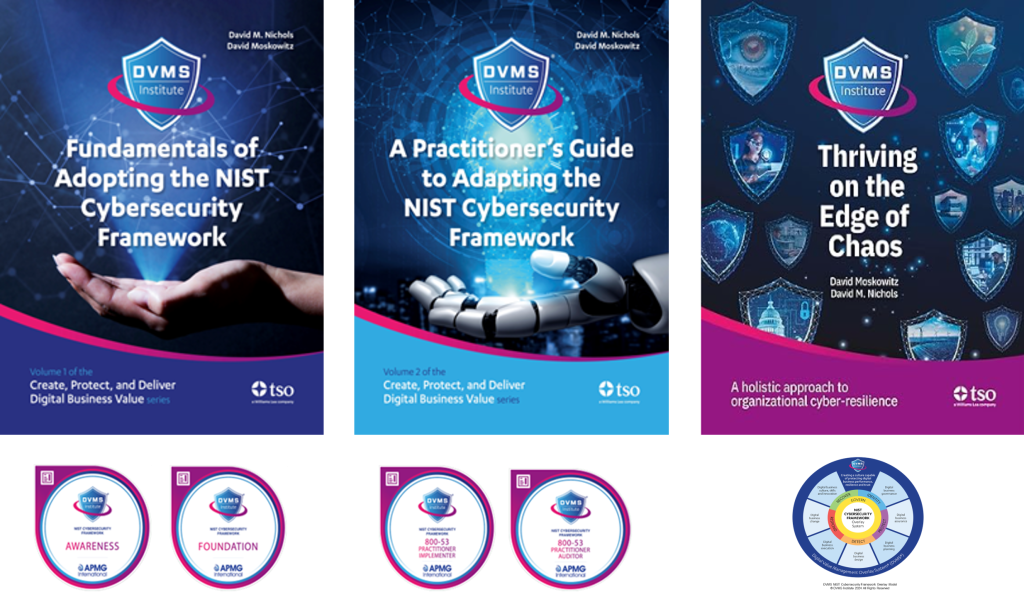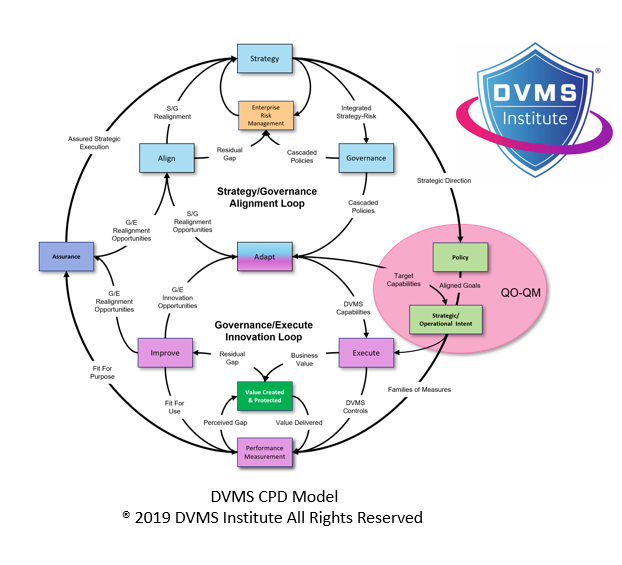DVMS – A Three-Dimensional View of Modern Digital Business Operations
Rick Lemieux – Co-Founder and Chief Product Officer of the DVMS Institute
Introduction: Beyond Traditional Cybersecurity
The Digital Value Management System® (DVMS) is not a framework or method—it is an overlay that provides a holistic, scalable, and adaptable structure that transforms how organizations understand and manage digital business risk and resilience. Its strength lies in offering a three-dimensional (3D) view of digital business operations, supporting a culture of continuous value creation, protection, and delivery. This 3D perspective is essential in the modern threat environment, where complexity, velocity, and interconnectedness challenge conventional linear thinking.
The First Dimension: Structure and Behavior
At its core, the DVMS applies a systems-based approach. Just as a car’s functioning depends on the integrated performance of its subsystems—engine, transmission, brakes—the same principle applies to businesses. Organizations are systems of systems: human resources, technology infrastructure, compliance, customer engagement, etc. The DVMS enables organizations to map these internal systems across their strategy, governance, and operational business layers, understand their interdependencies, and identify how their structure influences behavior.
This approach is grounded in systems thinking, emphasizing that change in one part of the organization affects the whole. By revealing how system structures drive organizational behavior, the DVMS supports intentional change and performance improvement. For example, altering the organizational structure—like flattening hierarchies—can result in greater agility and communication flow, enhancing resilience and operational efficiency.
The Second Dimension: Strategy-Risk Integration
The DVMS introduces a unified concept called “strategy-risk,” a deliberate departure from treating strategy and risk as separate domains. Strategy-risk reflects that business decisions—particularly those involving digital capabilities—are inherently risk-laden. Rather than viewing risk as something to mitigate post hoc, the DVMS integrates it directly into strategic planning.
This integration ensures organizations consider every strategic initiative’s security and resilience implications. Whether rolling out a new digital product or adopting a cloud or SaaS infrastructure, the DVMS asks “can we?” and “how should we?” to create, protect, and deliver value concurrently. This dual perspective—value creation and protection—is embedded in the DVMS’s CPD (Create, Protect, Deliver) Model, giving leaders a coherent lens for understanding the full life cycle of digital initiatives.
The Third Dimension: Dynamic Knowledge and Cultural Awareness
Perhaps the most profound contribution of the DVMS is its attention to cultural dynamics and knowledge flow. Through the 3D Knowledge Model, organizations examine how teams learn from the past, collaborate in the present, and align with future strategic priorities. This model includes:
- X-axis: Past, current, and anticipated knowledge.
- Y-axis: Inter-team collaboration and mutual impact.
- Z-axis: Strategic alignment and cultural coherence.
This dimension ensures that cybersecurity is not confined to technical tools or IT departments but is instead recognized as a function of organizational learning and behavior. For instance, when teams operate in silos, threats can go undetected or unaddressed. By contrast, organizations become more resilient and adaptive when culture supports open inquiry, shared accountability, and questioning assumptions.
Operationalizing the 3D View: The Z-X and CPD Models
The DVMS Z-X Model identifies seven minimum viable capabilities (Govern, Assure, Plan, Design, Change, Execute, Innovate) encompassing all organizational functions. These capabilities provide the scaffolding for applying the 3D view. Everything an organization does maps to one or more of these areas, allowing for holistic visibility and coordinated improvement efforts.
Simultaneously, the CPD Model operationalizes digital value by framing it as a continuous loop. Unlike traditional linear approaches—create then protect—the CPD Model mandates concurrent value creation and protection. This prevents the common problem of bolted-on cybersecurity that fails to integrate with real-time operations and decision-making.
Applying Profiles and Tiers: Feedback and Continuous Improvement
To enable benchmarking and improvement, the DVMS leverages the NIST CSF’s concept of Profiles and Tiers. Organizations use Profiles to assess their current and target states, while Tiers measure the maturity and rigor of their governance and risk management practices. This supports an evidence-based approach to continuous improvement that aligns with DVMS’s principles.
Conclusion: From Complexity to Clarity
The DVMS turns the chaos of digital transformation into a structured opportunity. By applying a three-dimensional view spanning structure/behavior, strategy-risk, and dynamic knowledge, organizations gain the insights necessary to manage complexity, adapt with resilience, and thrive in uncertainty. Far from being a static framework, the DVMS is a living overlay continuously evolving alongside the business, embedding cyber resilience into the enterprise’s DNA.
In a world where digital business is the business, the DVMS offers the roadmap to see, think holistically, and act decisively.
About the Author

Rick Lemieux
Co-Founder and Chief Product Officer of the DVMS Institute
Rick has 40+ years of passion and experience creating solutions to give organizations a competitive edge in their service markets. In 2015, Rick was identified as one of the top five IT Entrepreneurs in the State of Rhode Island by the TECH 10 awards for developing innovative training and mentoring solutions for boards, senior executives, and operational stakeholders.
In today’s digitally driven economy, cyber disruptions are no longer an “if” but a “when.”
The DVMS Institute’s Certified Training Programs teach organizations the skills to build a Holistic and Culture-Aligned Overlay System capable of coordinating Adaptive, Governance, Resilience, and Assurance actions across a Complex Digital Ecosystem.
Achieving true cyber resilience across a complex digital ecosystem requires seamless alignment between organizational Strategy, Governance, and Operations, underpinned by a culture dedicated to sustaining and continuously innovating organizational digital value.

The DVMS positions cyber resilience as a strategic, enterprise-wide capability powered by the Institute’s CPD, Z-X, and 3D Knowledge models.
This systems-based approach to cyber operational resilience demands active engagement from all members of the Digital Ecosystem, with each member playing a distinct role in proactively identifying and mitigating the systemic risks that threaten digital business operations.
This adaptive, forward-looking approach to Governance, Resilience, and Assurance (GRA) positions businesses to:
- Maintain Operational Stability Amidst Constant Digital Disruption
- Drive Agility and Trust Across Your Digital Ecosystem
- Satisfy Critical Regulatory and Certification Requirements
- Leverage Cyber Resilience as a Competitive Advantage
DVMS Explainer Videos
- Architecture Video: David Moskowitz explains the DVMS System
- Case Study Video: Dr. Joseph Baugh Shares His DVMS Story.
- Overlay Model – What is an Overlay Model
- ZX Model – The MVC’s that power operational resilience
- CPD Model – Adaptable governance and assurance
- 3D Knowledge Model – Enabling holistic organizational learning
- FastTrack Model – A phased approach to cyber resilience
Digital Value Management System® is a registered trademark of the DVMS Institute LLC.
® DVMS Institute 2025 All Rights Reserved




